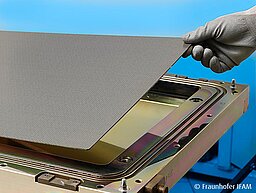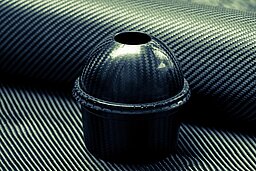New materials in aircraft construction: efficient pretreatment with atmospheric and low pressure plasma
Aircraft construction has seen a fundamental shift in the materials used in that industry. In the past, aluminum alloys were used almost exclusively for aircraft outer skin and stringers. Today, these components are manufactured primarily from carbon-fiber reinforced plastic (CFRP).
Thanks to plasma coating not only a longer lifetime and product safety can be achieved but also a significant cost reduction.
Surface treatment with Plasma in aircraft construction is an innovation driver that offers many outstanding advantages:

- Plasma pretreatment improves stability of CFRP components.
- Openair-Plasma® enables reliable high-quality processing in downstream bonding and painting operations.
- Openair-Plasma® makes possible for the first time selective, robot-guided inline plasma pretreatment on large-format components.
The first industrial application of these materials goes back to 2007, when Boeing used them in its B787 and Dreamliner aircraft. CFRP has been further enhanced since then and today the Airbus A350WXB consists of more than 40% CFRP materials, to cite one example.
Long-term stable corrosion protection provided by plasma polymerization: environmentally responsible, without toxic Cr6 primers
Until now, primer systems containing hexavalent chromium (Cr6) have been used to ensure optimal corrosion protection in aircraft construction, with long-term warranties for up to 30 years.
The PlasmaPlus® process replaces highly toxic Cr6 primers with plasma polymerization, which is a targeted, dry chemical plasma coating. Plasma energy combined with ultra-fine and absolutely uniform plasma coating also increase surface tension, which provides optimal surface preparation for painting and exhibits outstanding adhesion characteristics for long-term stability of bonded joints.
Aurora Plasma technology: Cleaning of carbon composite components prior to painting or bonding

One example of the use of the Aurora plasma technology is the pretreatment of carbon fiber turbine blades prior to structural bonding with the turbine metal hub. This combination of materials allows the construction of light and quiet turbine engines.
One clear advantage of the Aurora low-pressure plasma process is the plasma’s ability to penetrate gaps and crevices and the possibility of treating complex geometries on all sides. All treatment steps can be clearly defined in terms of sequence, intensity and formulation. During the treatment cycle, ionizable functional gases and fluids are processed inside the low-pressure chamber. The method is simple and easily reproducible.

Plasma polymerization release coatings for clean and easy demolding
The application of plasma-polymer separation layers offers a clear alternative here.
Depending on the complexity and size of the component, the layers are applied in the PlasmaPlus® process (atmospheric) or in the Aurora plasma process (low-pressure chamber process).
High-tech composites: Release agents eliminated thanks to Openair-Plasma® and Aurora Plasma technology
The use of fiber-reinforced plastics offer considerable advantages in terms of weight savings when building aircraft. In this dimension, fiber-reinforced plastics, particularly carbon fiber (CFRP) and glass fiber (GFRP), are substantially more stable than metallic structures.
The production of the predominantly large-area components takes place as a layer structure of so-called "prepregs" in the autoclave. To ensure easy demolding, it is necessary to address the adhesion to the mold itself. Solvent-based release agents such as Frekote® are often used. Release agents of this type have the disadvantage that residues remain on the component during demolding. These must be removed in complex manual work steps.
Benefits of plasma release coatings:
- No elaborate manual cleaning, thus increasing cycle times
- No contamination in the mold and the component
- No solvent-based release agents and cleaners, VOC reduction
- Improved, uniform surface quality and structure
Long-term corrosion protection for titanium and aluminum rivets thanks to Openair-plasma® treatment

Rivets remain one of the most common means to assemble aircraft components. These rivets, made of titanium or aluminum alloys, are subject to enormous stresses as a result of high humidity and huge temperature changes that make corrosion protection a challenge.
Surface treatment with Openair-Plasma® technology is a simple means here too to prepare surfaces using micro-cleaning and surface activation for optimal anti-corrosion coating.
Plasma pretreatment of Kevlar, fiberglass, carbon or UHMWPE for producing prepregs
Prepreg materials (pre-impregnated fibers) are pre-impregnated textile semi-finished products which are used for producing fiber-reinforced components. Under pressure and temperature several layers of pre-pregs are melted together. In addition to the arrangement of the prepregs, the optimum adhesion of the fiber to the reaction resin is most critical for the later stability of the complete component.
Pre-treatment of fabric using Aurora Plasma
Effective load transfer between the fiber and the matrix resin requires a clean fiber surface before the resin is applied. By pretreatment of the fiber tissue with Aurora plasma, an optimum penetration ability is achieved.


Pretreatment of fabric webs in contract manufacturing
Plasmatreat offers contract manufacturing services (toll treatment) through their subsidiary in the US for pretreatment of tissue webs before processing to the prepreg. For this purpose, a low-pressure plasma special system with a treatment width of 1.50m (60 inch) including wrapping (roll-to-roll) is available.

